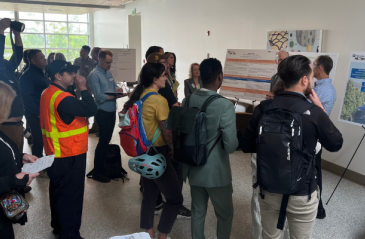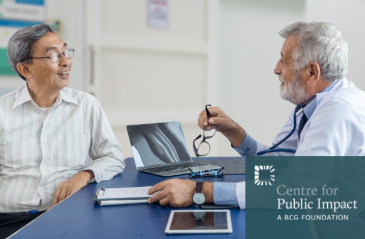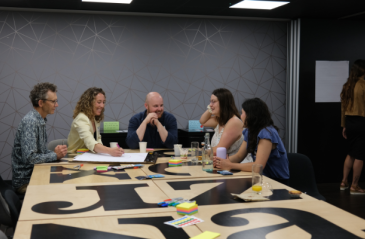
The information barriers holding back climate action and how to break them

How do @SteveDavisPATH and @PATHtweets promote global health innovation?
Share articleMillions of lives have been saved thanks to @PATHtweets' vaccine vial monitor
Share articleMeasurable results and 'constant engagement' with govt are both crucial, says @SteveDavisPATH
Share articleWe put our vision for government into practice through learning partner projects that align with our values and help reimagine government so that it works for everyone.
Picture: Steve Davis with a 24 year old mother of two. She is HIV positive and, thanks to the services of ProVIC, has given birth to two HIV negative children. (credit PATH/Felix Masi)
Steve Davis is quick to make a polite correction. “I'm glad you think that PATH is a powerful organisation, but impactful is what we really try to be,” he says, smiling. There's little doubt they have succeeded on that score.
Although it perhaps lacks the profile of some other global NGOs - “sometimes I joke that we are ‘the biggest NGO you've never heard of',” admits Davis - it can nonetheless call on a scale and sustainability, results and record that must be the envy of many of its peers. Set up 40 years ago, PATH straddles the worlds of healthcare and international development. Focusing on global health innovation, it seeks to save lives and improve health by accelerating innovations in five key areas: vaccines, drugs, diagnostics, devices, and system and service innovations.
As president and CEO since 2012, Davis has a role akin to a politician's: part fund-raiser, part administrator, part communicator in chief. “And you've also got to execute on the projects,” he adds. “You've got to be constantly doing advocacy and driving the mission with our different stakeholders - governments, the private sector, other partners, and so on.”
Although PATH operates around the world, it focuses most of its attention on Africa and Asia, working with countries to help address their biggest health challenges. Asked to identify an example of where it has made the biggest impact so far, Davis pauses before citing the vaccine vial monitor.
“This characterises so much of what we are trying to do,” he explains. “It's not ours. We're not a distribution company, we're not a manufacturer - we're an innovation company. Previously, we didn't know if a vaccine had been damaged by the heat, but this sticker/label - just like a coin - is fixed onto a vaccine vial and changes colour if it gets hot. It came from a different industry, but the process was very important: engaging the vaccine manufacturers, and working with the company that had the intellectual property and with the World Health Organisation. Millions of lives and dollars have been saved - all thanks to this simple tool.”
Because of its role at the intersection of different sectors, governments and other international bodies, PATH has long made a priority of building bridges between different actors and organisations. It's something that Davis is very proud of. “I think we are really at the driving edge of how to create multi-sector partnerships,” he says. “We spend a lot of time thinking about, and working across, almost every health development issue - how to bring the private sector in, how to make sure it is led by government, how to get things to scale.”
But it's not easy. Davis goes on to say that there is no secret sauce, and instead cites a raft of lessons gleaned from many years at decision-making tables in countries large and small, developed and developing. “There usually are good intentions, but the reality is that these are really different environments in which to work,” he points out. “There are different languages, different stakeholders, different rhythms and drivers of the businesses, which all affect how decisions get made. I joke sometimes that I want someone who knows what an SDG is and what a P&L is - these are the people you want in the room.”
He also points out that partnerships never stay still. Instead they ebb and flow, depending on need and circumstance. “We like to adopt a dynamic portfolio approach,” he says. “We don't want our projects to be one-offs. Take our relationship with GSK, for example. Sometimes we can be working on cocreations of products or licence agreements; other times it will be more philanthropic in nature. You need to be flexible, as you would in a normal business relationship.”
Among its array of priorities is the matter of achieving measurable results. “We're obsessed by this,” says Davis, speaking like the management consultant he once was (prior to joining PATH, he served as director of social innovation at McKinsey).
Measuring results, however, is not straightforward. But while there is no one-size-fits-all solution, Davis is confident they are doing all they can to maximise the effectiveness of their programmes. “There has been a lot of work and literature about how to correctly approach and assess social impact,” he points out. “I think we are making progress towards more established criteria, but there will never be one single measure that is the social impact equivalent of profit. The Holy Grail on this is to come up with a point where those kind of corporate social impact measurements are deeply ingrained into all financial reporting requirements - I think we will get there in the next couple of decades.”
In the meantime, PATH has a robust measurement and learning group which seeks to get early clarity on the value proposition of each opportunity it is presented with. “So we look at the inputs, outputs and outcomes,” he explains. “In health it is a little easier because people get sick or they die, as opposed to a democracy movement or how well people are educated. But we're totally focused on this. Our work directly touches 150 to 200 million people a year - which is a very unusual number for an NGO - and this doesn't even include the large-scale advocacy projects we are also working on. But we want each and every one to benefit from what we do. That's how we have always operated.”
Such scale demands significant resources, however. How do they fund all their activities? “An NGO can never have enough resources,” he replies. “We are non-profit and we are working on a variety of business models to constantly raise money. We have been around for 40 years, so we've been successful in doing that. About half our money comes from The Bill & Melinda Gates Foundation - we are one of their largest partners and grantees. But we're constantly trying to raise money, either from governments or from foundations. We're also doing some corporate engagement models and there are some areas where we've been able to secure some private equity.”
A core aspect of its global activities is what Davis describes as its “constant engagement” with governments. “We're talking with government all the time - national, state and local,” he adds. “We try and orient our work around systemic change that a country could adopt - a tool or innovation - which can help drive the elimination of a disease like malaria, for example.”
Davis goes on to say that governments loom large for a whole variety of reasons. “My strong personal view - it's part of what I teach at Stanford - is that you cannot get to scale in social innovation without governments, because ultimately they are the biggest procurer, they are the regulator, and they are the policymaker that shapes the environment,” he points out. “But 20 years ago this agenda was driven out of London or Washington or Geneva. No more. Today, it is driven out of the national and local governments - which is, of course, exactly how it should be.”
That's the good news. Unfortunately, there remains more work to be done in the developing world - particularly around strengthening institutions. PATH is doing its bit by working with governments to help them build the capacity they need to manage the new apps and technologies which have come on stream in recent years, and make them interoperable.
“The level of fragmentation has almost turned digital advances into a liability,” says Davis. “We've reached a situation where ministers of health are feeling overwhelmed by so much of what is out there, and where voluntary health workers are having to try and use four or five mobile apps because different funders have produced different things. So we are working with governments to help them manage these new technologies and help them use data differently.”
Davis, who in addition to his role at Stanford also sits on councils and boards aplenty, is rarely in one place for long. Perhaps that's as it should be - PATH is global, after all, and he is clearly not someone who wants to spend all his time behind a desk at its American headquarters in Seattle. His busy schedule - this interview took place in London just after he had flown in from China and before he returned to the US - allows him and the organisation to pursue a number of key priorities, all of which are underpinned by the aim of driving transformative global health innovation.
“I want us to be at the forefront of pulling better service delivery ideas together,” he says. “We've put a lot of resources into breaking down silos - looking at the first 1,000 days of life and helping governments, clinics, and health workers collaborate, so that they are not just going in with an HIV project or a nutrition project. We are also focusing hard on the next batch of diseases that can be eliminated. We've eradicated smallpox as a human disease, and we're on the verge of seeing this happen with polio. But now it is about the next ten we could eliminate. This is extraordinary and exciting. It won't happen tomorrow, but it will happen in my lifetime. We are also advancing our work in digital health. The world has been turned upside down by digital technology, but the global health community has been quite slow to grasp these opportunities and we are trying to improve this.”
Davis crackles with energy and optimism about what lies ahead. And certainly, despite the negative tenor of some of the headlines over the past year or so, he believes the future is actually remarkably positive. “Although I am deeply troubled by some of the political changes we have seen in the last year, on the other hand I think the headlines have overpowered the trend lines,” he concludes.
“Globally, people are living longer and with far better health and education results - these numbers are improving every day. We need to stay focused on that and continue to safeguard and accelerate this momentum - which is exactly what we are doing and will be doing at PATH.”












